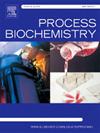An innovative utilization approach for by-products of biogas desulfurization:Co-hydrothermal treatment of sulfur with biogas slurry to prepare sulfur-enriched liquid fertilizer
IF 3.7
3区 生物学
Q2 BIOCHEMISTRY & MOLECULAR BIOLOGY
引用次数: 0
Abstract
The sulfur bioavailability enhancement introduced by the co-hydrothermal treatment of sulfur with corn straw biogas slurry was evaluated, and the effects of different sulfur speciation on plant and soil were explored via kale pot experiment. Based on this, an innovative methodology was proposed to prepare sulfur-enriched liquid fertilizer via co-hydrothermal treatment of BS and sulfur. The addition of sulfur element promoted the yield and quality of kale, and significantly impacted soil microorganisms. Notably, after co-hydrothermal treatment of biogas slurry and elemental sulfur, such effect on kale and microorganisms was more pronounced among different treatments due to the diverse sulfur speciation, where the maximum fresh weight, dry weight, and anthocyanin content of seeding kale increased by 115.52 %, 79.87 %, and 357 % compared with the control group. Moreover, co-hydrothermal treatment improved the bioavailability of sulfur. After applying hydrothermal sulfur, the sulfur content of kale increased by 18.65 % and 21.95 % compared to the experimental group treated with elemental sulfur and sulfate, respectively. The enhancement of hydrothermal sulfur on the kale growth was attributed to the improved sulfur utilization efficiency, the alleviated salt stress, the reduced plant pathogens, and the enriched plant growth-promoting microbes.
沼气脱硫副产品的创新利用方法:用沼气浆协同水热处理硫磺以制备富硫液体肥料
通过甘蓝盆栽实验,评估了硫与玉米秸秆沼气浆共水热处理对硫的生物利用率的提高,并探讨了不同硫分对植物和土壤的影响。在此基础上,提出了一种创新方法,即通过 BS 与硫的共水热处理制备富硫液体肥料。硫元素的添加促进了甘蓝的产量和质量,并对土壤微生物产生了显著影响。值得注意的是,沼气浆和元素硫共同水热处理后,由于硫的种类不同,对甘蓝和微生物的影响在不同处理中更为明显,与对照组相比,播种甘蓝的最大鲜重、干重和花青素含量分别增加了 115.52 %、79.87 % 和 357 %。此外,共同水热处理提高了硫的生物利用率。与使用元素硫和硫酸盐处理的实验组相比,使用水热硫后甘蓝中的硫含量分别增加了 18.65 % 和 21.95 %。水热硫对甘蓝生长的促进作用可归因于硫利用效率的提高、盐胁迫的缓解、植物病原体的减少以及植物生长促进微生物的丰富。
本文章由计算机程序翻译,如有差异,请以英文原文为准。
求助全文
约1分钟内获得全文
求助全文
来源期刊

Process Biochemistry
生物-工程:化工
CiteScore
8.30
自引率
4.50%
发文量
374
审稿时长
53 days
期刊介绍:
Process Biochemistry is an application-orientated research journal devoted to reporting advances with originality and novelty, in the science and technology of the processes involving bioactive molecules and living organisms. These processes concern the production of useful metabolites or materials, or the removal of toxic compounds using tools and methods of current biology and engineering. Its main areas of interest include novel bioprocesses and enabling technologies (such as nanobiotechnology, tissue engineering, directed evolution, metabolic engineering, systems biology, and synthetic biology) applicable in food (nutraceutical), healthcare (medical, pharmaceutical, cosmetic), energy (biofuels), environmental, and biorefinery industries and their underlying biological and engineering principles.
 求助内容:
求助内容: 应助结果提醒方式:
应助结果提醒方式:


